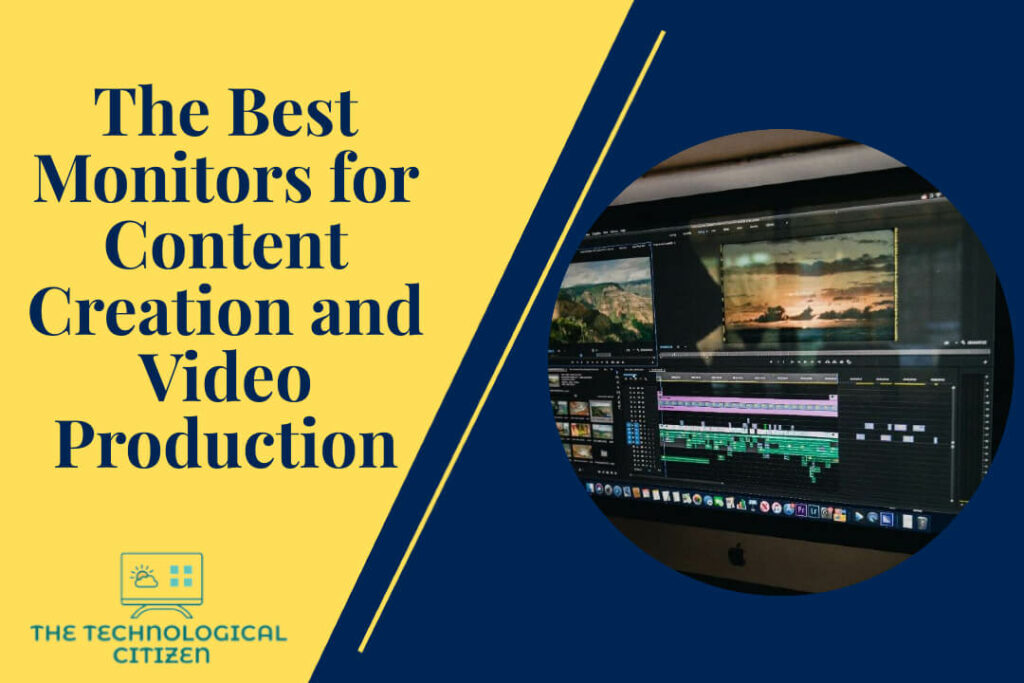Quality budget monitors have been recently making waves in the computer industry. As more and more people choose online content creation as a career, the need for affordable monitors that suit all kinds of content creation has also increased.
Monitors for content creation and video production need to have many exclusive features that ensure the quality of the output content. The color accuracy, response time, exporting capability, etc., should all be high for these monitors. Also, they must be easy to operate for both beginners and pros in the content creation industry.
The article below analyses the need for a monitor in content creation, the best monitor options for video editing, and the best budget buy available in the section.
What type of monitor is best for video editing?
If you don’t have the right monitor, video editing can be daunting for both beginners and pros. You may spend a reasonable sum of money but end up with an underperforming monitor. This is why you have to pay attention to the following features of your favorite monitor before buying it for video editing.

1. Screen Size
Screen size is one of the most essential factors to look for in a monitor for video editing. The monitor’s size determines the comfort of working on the editing process. Especially if you are doing long or overnight editing sessions, reasonably sized monitors willbe helpful.
The best and most common screen sizes for video editing purposes are 19, 24, 27, and 32 inches. Monitors that are sized beyond 40 inches are also available. But you need a big room to accommodate such ultra-wide monitors.
If portability is your priority and you need to edit on the go, 19-inches monitors are the best option for you.
2. Resolution
A monitor with the highest possible resolution is necessary for video editing. 4K is the best resolution option you can have for a monitor as of now. However, 4K works the best with editing, especially with the color grading aspect of editing.
If you don’t have the budget or other requirements for purchasing a 4K monitor, you can always opt for the 1080p ones and use 4K proxies for editing. 1080p monitors are a good compromise between the resolution quality and the price.
3. Panel Types
Manypanel-type options are available for editing monitors. The most common ones are LCD, OLED, TN, IPS, etc. Each of them has pros and cons, but the editing needs of the user should influence the choice.
LCD monitors are the best in color gamut, contrast ratio, and brightness level. IPS panels are famous for the best possible viewing angles. OLED monitors offer wider viewing angles, high brightness levels, and high contrast ratios.
OLEDs are the most expensive ones among them all. LCD monitors come in more affordable models.
4. HDR Technology Support
HDR, or High Dynamic Range technology,makes the video editing process more effective. This technology provides better color contrast and intensity to the visuals and images.
This technology provides better color grading options than the standard dynamic range display technology. Although HDR10+ is one of the most advanced forms of HDR technology available, the HDR10 version is sold the most.
5. Connectivity
Connectivity is also very crucial when choosing a monitor for video editing. Having the monitor with the maximum connectivity options is always ideal, as it provides more opportunities to import and export files.
The most necessary input ports your monitor should have are HDMI, USB, Optical, Mini Display Port, Thunderbolt, etc. These input options are helpful during the post-production phase of video content creation.
6. Color Gamut and Depth
Having a monitor that supports a wider color gamut and depth would help improve the quality of your video content. Wider color gamuts provide the most minute details on the visuals, which allows it to reach more audiences.
Some popular color gamut options are Adobe RGB, DCI-P3, etc.
7. Calibration
Calibration is critical to the longevity and durability of any monitor, especially for monitors that engage in intense work like video editing. Some monitor models come with calibration software, while some do not.
If you are a beginner with computer monitors, it is always ideal to purchase a monitor with calibration software and engage in calibration now and then.

What is the best 4K monitor for filmmaking?
There are numerous options available for 4K monitors that support high-quality filmmaking. These monitors feature high resolution, adequately calibrated color gamut, diverse connectivity options, high refresh rate, etc.
Some of the best 4K monitors for filmmaking are as follows.
- Philips 276E8VJSB UHD 27” 4K Monitor
- Z-Edge U2814K 28” Monitor
- BenQ PD2700U 4K Monitor
- Samsung LU32J590UQNXZA Monitor
- LG 32UN880-B Monitor
- Asus PA329CV Monitor
The best monitor for video editing and color correction
Even if you are a video and photo editing beginner, you can create good products if your monitors have the best editing features. There are many monitor models available now that are great for photo and video editing.
Some of the best monitor options available for video editing and color correction are:
- BenQ PD2700U 4K Designing Monitor
- Philips 276E8VJSB 27″ IPS 4K UHD Monitor
- SAMSUNG Curved CF39623.5” Computer Monitor
- BenQ QHD Photo Vue SW270C 27 Inch 1440P Photo Editing IPS Monitor

Summary
Content creation and video production are the most growing industries currently. Computer manufacturers are creating modern monitor models that support these new-age careers and jobs. Some of the popular brands that engage in the production of such monitors are ASUS, SAMSUNG, Philips, etc.
The most important things to look for in a monitor for video editing are screen size, resolution, panel types, HDR support, color gamut, connectivity, color depth, capacity to calibrate, etc.
FAQs
-
Should I buy a monitor or TV for video editing?
Although TV monitors are generally used instead of computer monitors in emergencies, it is not ideal to always use them for video editing and similar complex purposes. Because it is not reasonably possible to accurately control a TV monitor’s display and color features like a proper computer monitor. So, if you need the best results for your video or photo editing needs, using a dedicated computer monitor is ideal.

